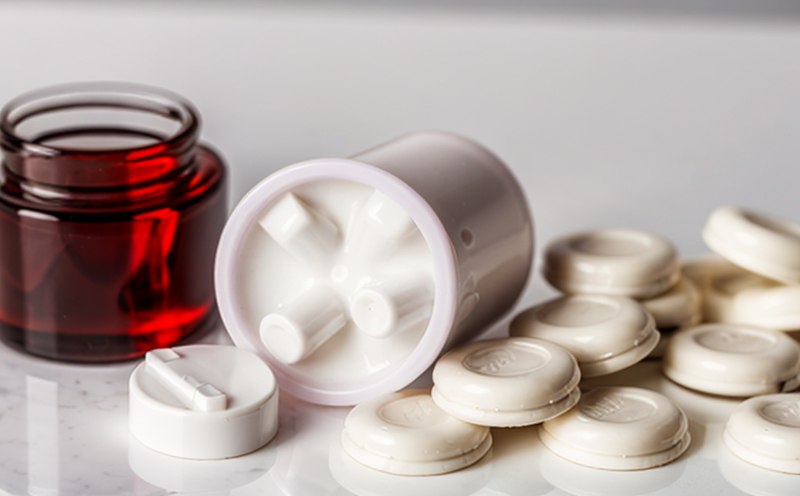USP Tablet Coating Moisture Barrier Testing
The USP USP Tablet Coating Moisture Barrier Testing is a critical procedure in the pharmaceutical industry to ensure that oral solid dosage forms meet stringent standards for stability and performance. This test focuses on evaluating the integrity of the coating applied to tablets, which acts as a moisture barrier, protecting the active ingredients from degradation due to humidity or moisture exposure.
The USP guidelines specify that the coating should provide an effective barrier to prevent water vapor penetration into the tablet core. The primary objective of this testing is to ensure that the coating maintains its integrity over time and under various environmental conditions. This is particularly important for medications with hygroscopic properties, as they are susceptible to degradation if exposed to moisture.
The test involves exposing coated tablets to controlled humidity levels in a chamber designed to simulate real-world storage and handling conditions. The moisture content of the coating is then measured before and after exposure. The difference between these values indicates the effectiveness of the coating in preventing water vapor from reaching the core of the tablet.
For accurate testing, it's essential that the coated tablets are prepared according to USP specifications. This includes ensuring a uniform thickness of the coating, proper drying procedures post-coating, and adherence to temperature and humidity control during storage. The use of appropriate instruments such as humidity chambers, balance scales, and moisture analyzers is crucial for obtaining reliable results.
The acceptance criteria for this test are stringent and must be met by all coated tablets produced in compliance with USP standards. If the coating fails to meet these criteria, it may indicate issues with the formulation or application process, necessitating corrective actions. Compliance with these standards ensures that medications remain stable and effective throughout their shelf life.
Understanding the importance of moisture barriers is crucial for quality managers, compliance officers, R&D engineers, and procurement teams involved in pharmaceutical manufacturing. By adhering to USP guidelines, manufacturers can ensure product integrity and patient safety. This testing not only meets regulatory requirements but also enhances the overall quality and reliability of the final product.
The process involves several steps: specimen preparation, exposure to controlled humidity conditions, measurement of moisture content before and after exposure, and analysis of the results against USP specifications. Each step is critical for obtaining accurate and reliable test data. Ensuring that all personnel involved in this testing are trained on these procedures guarantees consistent and high-quality results.
In conclusion, USP Tablet Coating Moisture Barrier Testing plays a vital role in maintaining the integrity and stability of pharmaceutical products. By adhering to strict guidelines and utilizing appropriate equipment, manufacturers can ensure that their products meet the highest standards of quality and safety.
Industry Applications
- Hygroscopic Medications: Ensuring that medications with hygroscopic properties do not degrade due to moisture exposure.
- Sustained Release Formulations: Protecting sustained release formulations from degradation by maintaining a stable environment around the active ingredients.
- Bioavailability: Maintaining optimal bioavailability of the drug by preventing premature dissolution or breakdown during storage and handling.
- Long-Term Stability: Guaranteeing that tablets remain stable over extended periods, ensuring consistent efficacy and safety.
The USP Tablet Coating Moisture Barrier Testing is essential for any pharmaceutical manufacturer producing products intended for long-term storage or exposure to varying environmental conditions. This testing ensures that the coating effectively protects the active ingredients from moisture, thereby enhancing the shelf life and stability of the medication.
Customer Impact and Satisfaction
The implementation of USP Tablet Coating Moisture Barrier Testing has a significant positive impact on customer satisfaction. By ensuring that coatings provide an effective barrier against water vapor, manufacturers can guarantee product integrity and efficacy. This not only meets regulatory requirements but also enhances the overall quality and reliability of the final product.
Customers benefit from products that are stable over extended periods, ensuring consistent efficacy and safety. This is particularly important for those with chronic conditions who rely on their medication to be effective and reliable. The testing process ensures that any issues related to moisture exposure are identified early in the manufacturing process, allowing for corrective actions to be taken promptly.
Moreover, compliance with USP standards demonstrates a commitment to quality and safety, which builds trust between manufacturers and customers. This can lead to increased customer loyalty and repeat business. By adhering to these strict testing protocols, pharmaceutical companies can ensure that their products meet the highest standards of quality and reliability, ultimately enhancing customer satisfaction.
Environmental and Sustainability Contributions
The USP Tablet Coating Moisture Barrier Testing contributes positively to environmental sustainability by ensuring that pharmaceutical products are stable over extended periods. This reduces waste associated with premature degradation or inefficacy due to moisture exposure. By maintaining the integrity of the drug formulation, manufacturers can extend the shelf life of their products, thereby minimizing the need for frequent reordering and production runs.
Additionally, this testing ensures that medications remain effective throughout their intended use, reducing the likelihood of environmental waste from unused or expired products. This aligns with broader sustainability goals by promoting resource efficiency and minimizing unnecessary product disposal. The use of moisture barriers also reduces the carbon footprint associated with manufacturing processes, as it can lead to more efficient production cycles.
Through adherence to USP standards, pharmaceutical companies contribute to a more sustainable healthcare ecosystem. By ensuring that products are stable and effective for their intended duration, manufacturers help reduce waste and promote responsible resource use. This aligns with global sustainability initiatives aimed at reducing environmental impact in the healthcare sector.





